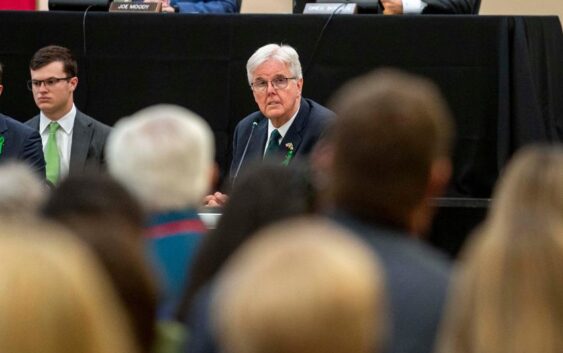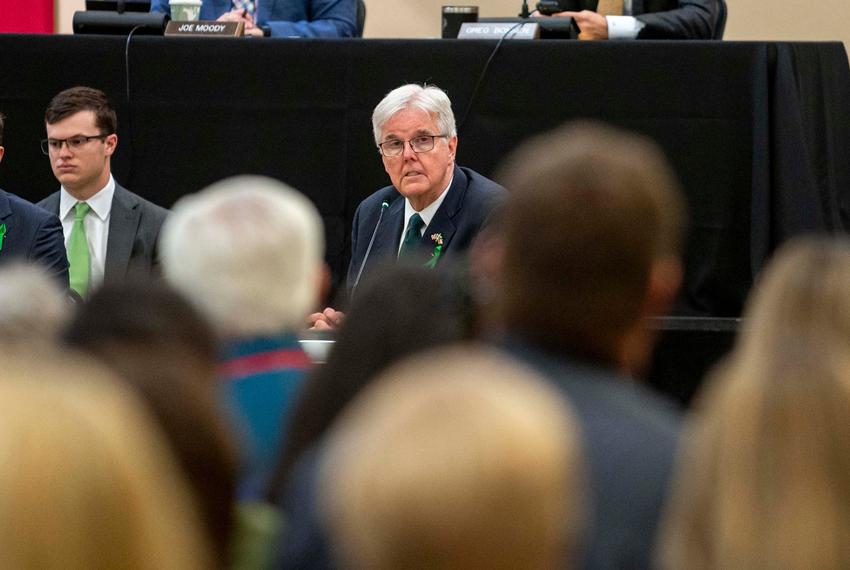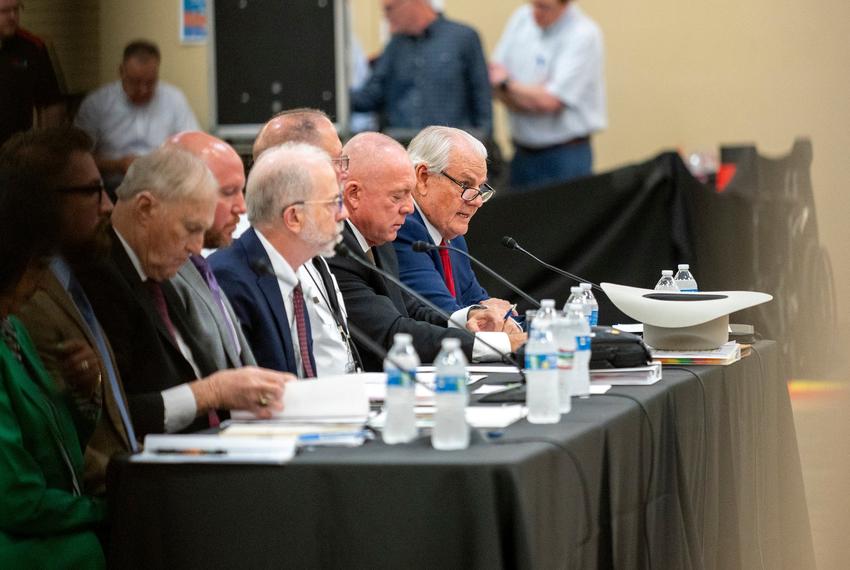- Florence to begin interviewing police chief finalists in January
- A West Texas county wants to better prepare for floods. Paying for it will be tricky.
- They couldn’t save their daughters’ lives in the July 4 floods. Now they’re dealing with the grief and the guilt.
- Austin could see heavy rains, possible flooding over the next few days
- Families of campers, counselors who died in Texas Hill County floods sue Camp Mystic
Top two Kerr County emergency officials say they were asleep as July 4 floods struck

Sign up for The Brief, The Texas Tribune’s daily newsletter that keeps readers up to speed on the most essential Texas news.
The top two emergency management officials in Kerr County told lawmakers Thursday that they were asleep in the early morning hours of July 4 when floodwaters rose. The disaster killed more than 100 people in their jurisdiction, including 27 young campers and counselors at Camp Mystic.
Kerr County Judge Rob Kelly, who is the head of county emergency management, and Kerr County Emergency Management Coordinator William Thomas testified to state legislators at a hearing in Kerrville that they woke up only after other local officials tried to reach them. Larry Leitha, the county sheriff, said he went to sleep without a worry about the weather.

Lt. Gov. Dan Patrick speaks during a joint legislative committee hearing on the July 4 floods in Kerrville on July 31, 2025.
Credit:
Ronaldo Bolaños/The Texas Tribune
Lt. Gov Dan Patrick, who attended the hearing, accused Kelly of being absent on July 4 as various leaders worked to get a handle on the disaster. Kelly said he was in the emergency operations center but did leave at one point to check on his wife. But Patrick, who was serving as acting governor that day while Gov. Greg Abbott was out of town, said Kelly wasn’t around.
“Judge Kelly, I never saw you on day one,” Patrick said. “I talked to the sheriff multiple times …. I talked to the mayor multiple times. We had a meeting when we got here … Everyone was here.”
“And I wasn’t,” Kelly said. “And I wasn’t”
The Kerr County officials’ testimony was their first public statements about what they had been doing the morning of the disaster, and they revealed that key officials weren’t awake to react to flood warnings in the critical early morning hours of July 4.
“One of the problems that this process is showing is we have a lot of folks who have titles but when the time came to act, they did not do so in a timely fashion,” Rep. Drew Darby, R-San Angelo, said during the hearing.
“The three guys in Kerr County who were responsible for sounding the alarm were effectively unavailable,” said Ann Johnson, D-Houston. “Am I hearing that right?”
When the flooding began, Kelly was at a house on Lake Travis outside of Austin, he said. Everything felt normal to him; he’d been getting ready for family to come over during the holiday weekend. He said Leitha, Texas Division of Emergency Management Chief Nim Kidd and Kerrville City Manager Dalton Rice tried to contact him while he slept.
Kelly said he woke up around 5 a.m., or 5:30 a.m., or 6 a.m. — he wasn’t quite sure. In Kerr County, rain had been pounding the south fork of the Guadalupe River and a wall of water was raging down the river toward unsuspecting communities that had no idea what was headed their way.
“We now know that by that time the flooding had already overtaken Camp Mystic, Heart O’ the Hills and La Junta, and several other upriver camps,” Kelly said, “something that I could never have imagined.”
Thomas, the emergency management coordinator, told lawmakers that he was home sick. He hadn’t been feeling well since July 2 and didn’t work on July 3, which he’d previously requested to take off anyway for another reason, he said. He missed two regular state emergency management calls that day, but said other county leaders typically receive written summaries afterward to make sure information reaches them even when Thomas isn’t working.
Thomas said he woke up around 5:30 a.m. after the City of Kerrville Emergency Management Coordinator Jerremy Hughes called his wife, who roused him.
Both Kelly and Thomas told legislators that they’d had no idea what was coming.

Kerr County Judge Rob Kelly (far right) answers questions during Thursday’s committee hearing.
Credit:
Ronaldo Bolaños/The Texas Tribune
But there were warnings: The National Weather Service issued a flood watch for the county on July 3, meaning flooding was possible, and pushed out increasingly dire flood warnings saying that flooding was happening or imminent starting at 1:14 a.m. July 4.
“Based on the data we had at the time, there was no clear indicator that a catastrophic flood was imminent,” Thomas said. “The rain fell in remote areas with limited gauge data; forecasts were not materially different from past events that did not result in flooding.”
Leitha, the sheriff, woke to a nightmare on July 4.
Calls came in early to the sheriff’s dispatch center, where two people were working, Leitha said. At 2:08 a.m., a caller asked about road conditions; at 2:53 a.m., a caller from River Inn Resort and Conference Center, which is near Camp Mystic, said they were starting to see high water.
Then the situation escalated: At 3:30 a.m., floodwaters were covering roads. A family was on a roof and requesting air evacuation.
An RV park needed evacuating. A caller with two young children needed help. A call came in from Camp Mystic at 3:57 a.m., seeking evacuation. Later, a deputy reported hearing kids screaming in the river.
A chief deputy contacted Leitha at 4:20 a.m., he said, but Leitha didn’t immediately try to reach the county judge.
“There was no time for formal orders,” Leitha said.
The two dispatch operators were juggling a lot, Leitha said. A volunteer fire department chief requested a Code Red alert at 4:22 a.m., which the county can push to people who have signed up to receive the warnings. A sergeant approved the request one minute later, but it didn’t get sent for another 45 minutes.
The legislators during the hearing underscored the need for warning systems such as sirens. The Kerrville mayor said he wanted to see a system built by next summer, and needed the state’s help to do that.
Lawmakers also heard stark contrasts in how local officials reacted to warnings before floods ravaged communities across Central Texas through the holiday weekend. In Kendall County, Judge Shane Stolarczyk said a state official made clear to the county emergency management coordinator that they needed to be “alert for heavy rain over the area in the late evening and early morning hours” and pay attention to RV parks and campgrounds.
Stolarczyk said their coordinator was up at midnight with an “uneasy feeling,” monitoring the situation and staying in touch with the sheriff’s office, which continued throughout the night and into the morning. The coordinator activated their emergency operations center at 4 a.m..
The local Kerr County officials told lawmakers that rural emergency response teams need more state support with equipment and training. They stressed the importance of educating visitors. They also called for expanded broadband service for the Guadalupe River area, which has limited cell phone reception.
The legislators said they were listening because they knew they needed to fix problems.
“The monster will be back in one form or fashion in this state,” Sen. Pete Flores, R-Pleasanton said.
The lineup for The Texas Tribune Festival continues to grow! Be there when all-star leaders, innovators and newsmakers take the stage in downtown Austin, Nov. 13–15. The newest additions include comedian, actor and writer John Mulaney; Dallas mayor Eric Johnson; U.S. Sen. Amy Klobuchar, D-Minnesota; New York Media Editor-at-Large Kara Swisher; and U.S. Rep. Veronica Escobar, D-El Paso. Get your tickets today!
TribFest 2025 is presented by JPMorganChase.